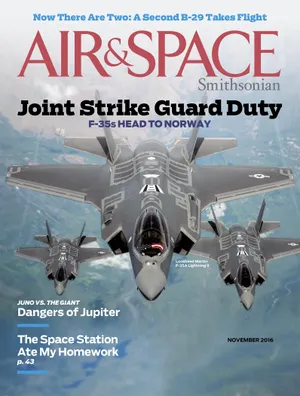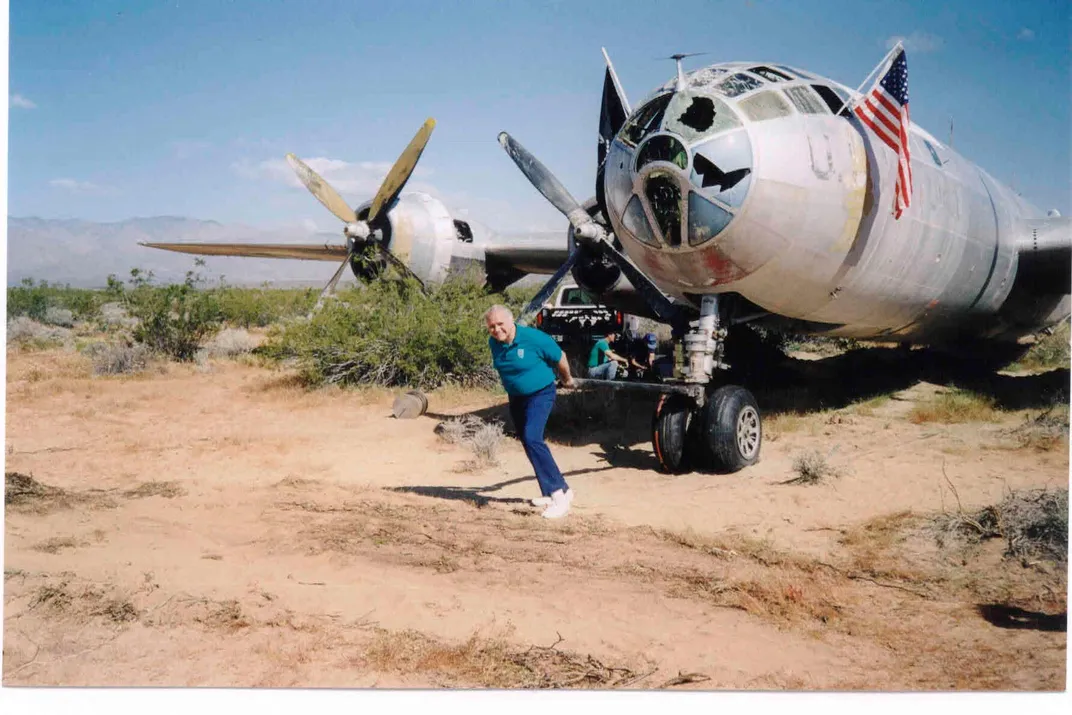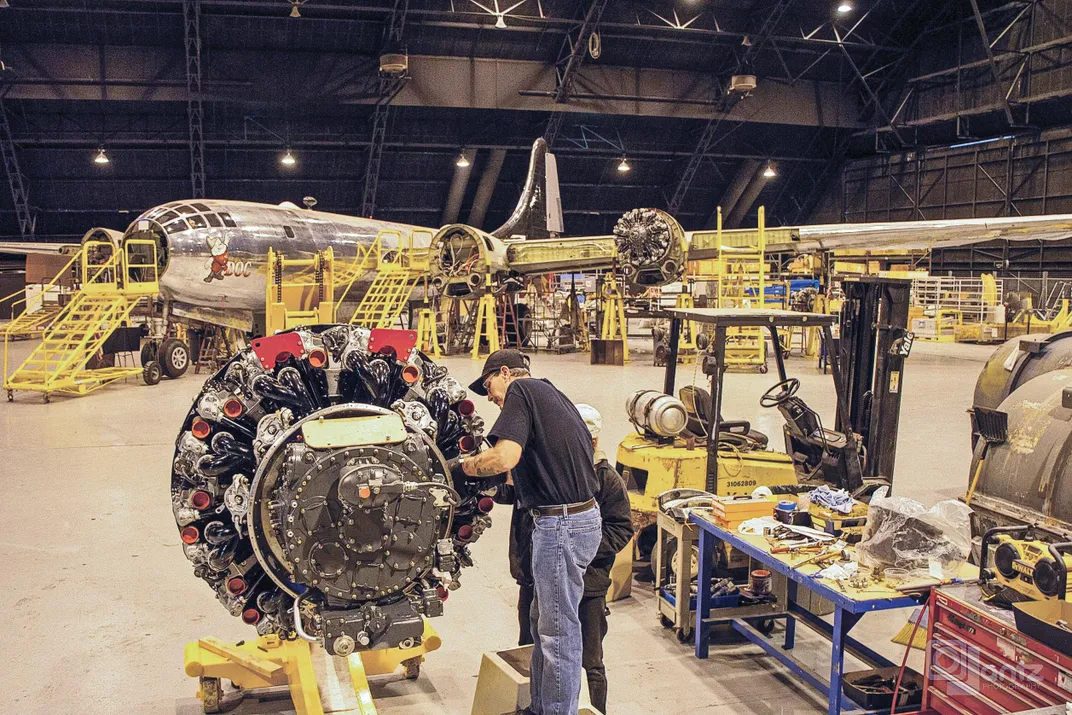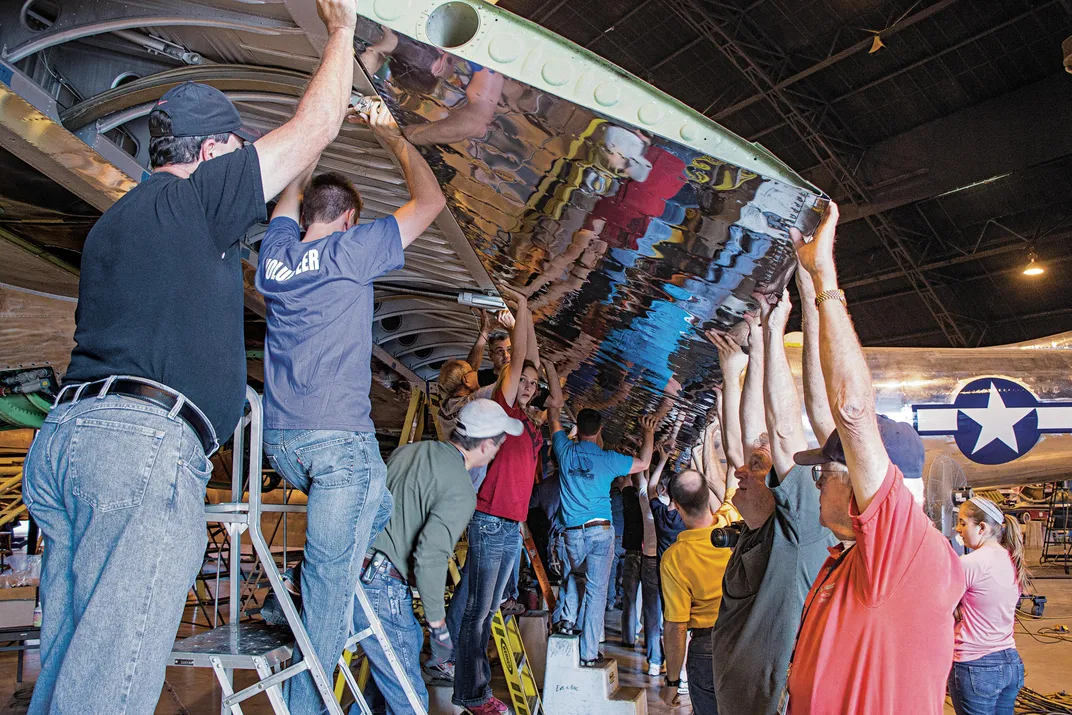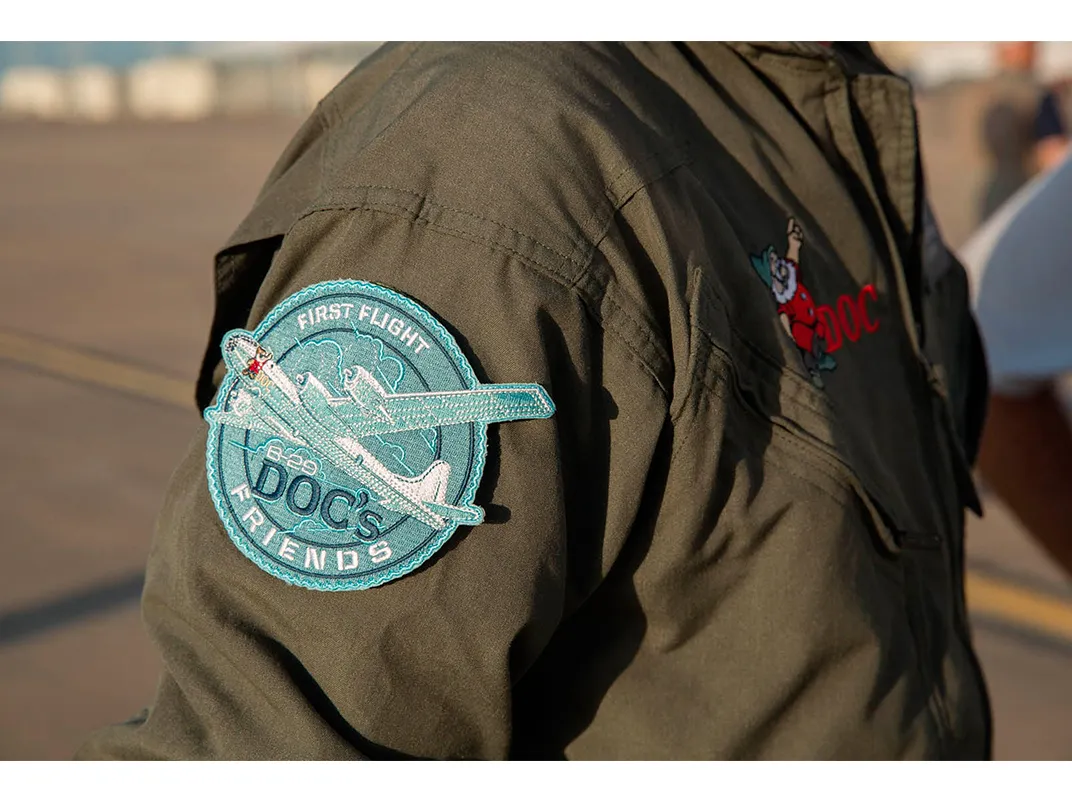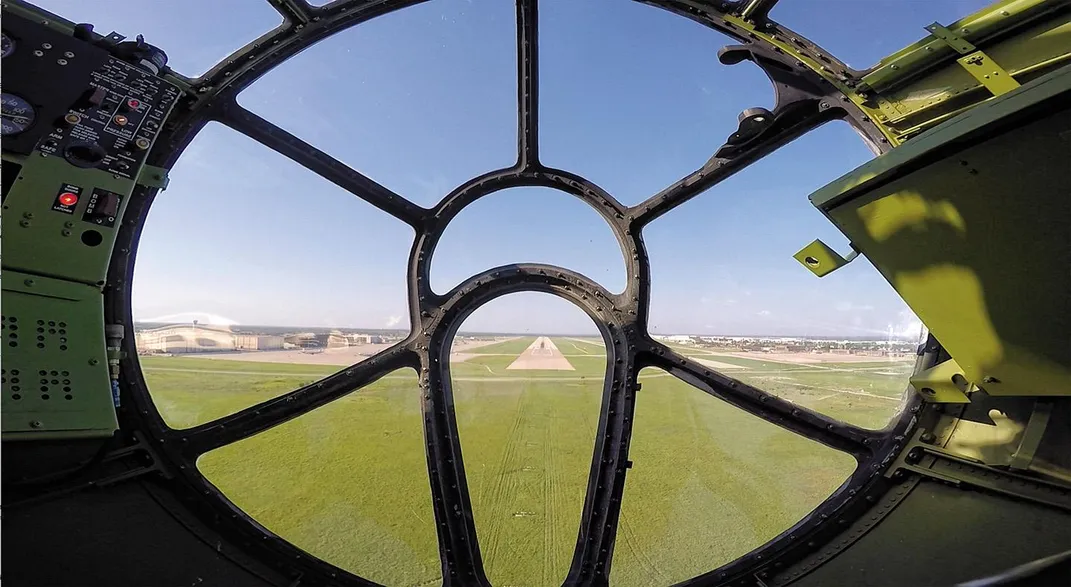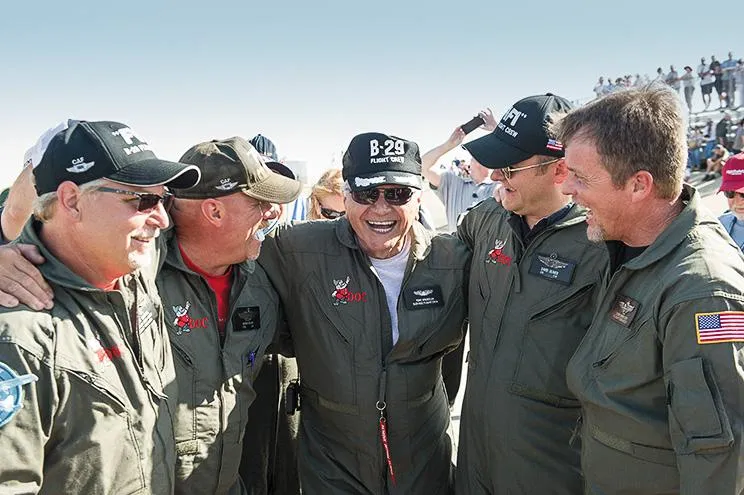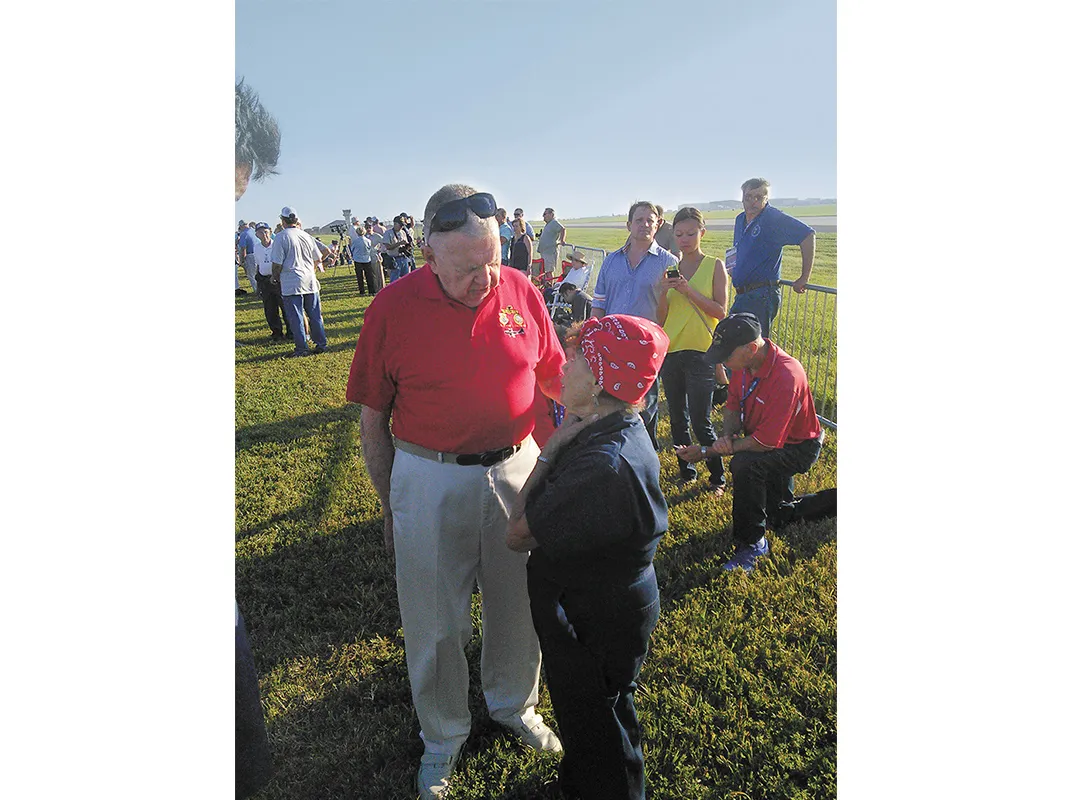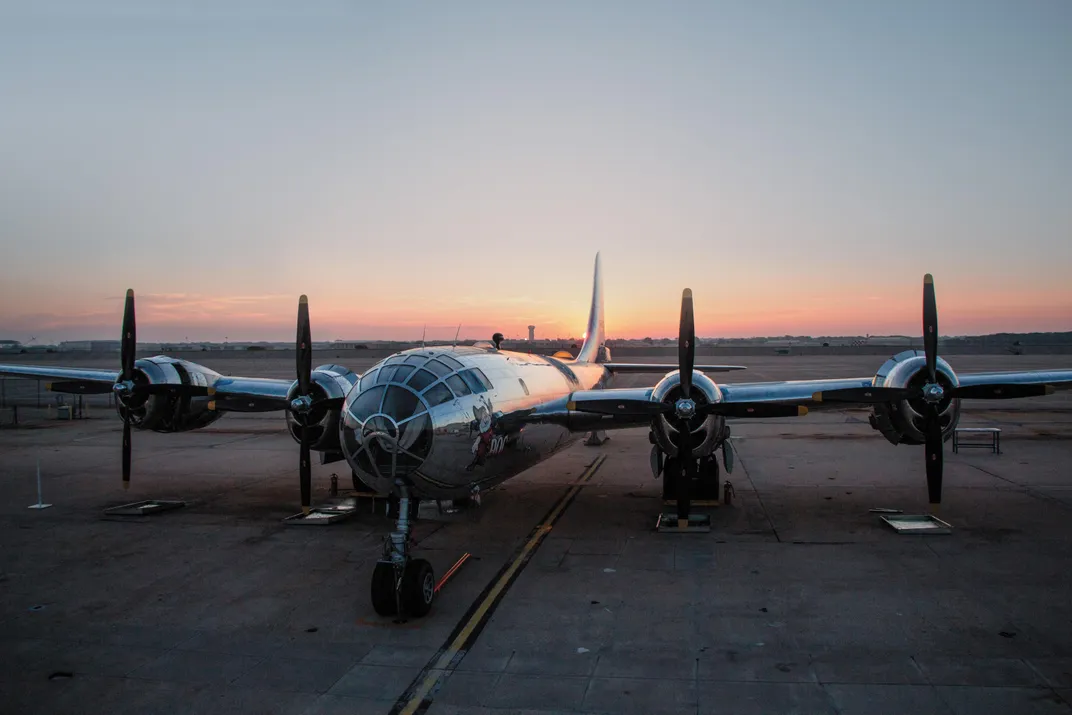Meet “Doc,” One of Only Two Flying B-29s in the World
For 42 years, Fifi was the only airworthy Superfortress. Now it has company.
/https://tf-cmsv2-smithsonianmag-media.s3.amazonaws.com/filer/b1/13/b113c943-3fe3-48a8-a82d-87b1d2ec940e/08r_on2016_docflight8_live.jpg)
On a grassy strip beside the runway at McConnell Air Force Base in Wichita, Kansas, it’s about to get hard to hold a conversation. Four enormous radial engines on the newly restored Boeing B-29 Doc are firing up nearby. It’s July 17, and here—near the site of the factory where the bomber was built in 1944—a crowd of restoration volunteers and assorted VIPs await Doc’s first flight since 1956.
“Being the eternal optimist, I guess I always thought this day would come,” says Tony Mazzolini. He was a regional manager at Continental Airlines until retiring in 2008, and spent spare time on the board of a Cleveland air museum as well as founding a local Commemorative Air Force chapter. Fifi, the CAF’s perennial airshow star, was the sole flying example of the superlative Boeing species that darkened the skies over Japan and ended a world war. The idea of a second, Ohio-based Superfortress to galvanize crowds hounded Mazzolini. “I have a love affair with this particular airplane,” he says.
In the 1950s, Mazzolini had been a U.S. Air Force flight engineer in North American B-25s, flying cold war electronic countermeasures (ECM) missions off the East Coast. He recalls seeing B-29s flown during that era for ECM too. Once, at Griffiss Air Force Base in New York, he even glimpsed a B-29 squadron nicknamed “Snow White and the Seven Dwarfs,” which included a B-29 named Doc. Some 30 years later, Mazzolini’s goal became finding a B-29—any B-29—that could be restored to flying condition. It would become an all-consuming quest that stretched across decades.
Worst-case assumptions, circa 1940: Hitler occupies the entire European continent; the fall of Britain is a fait accompli. The first responder is the four-engine Boeing B-17 Flying Fortress, but that was 1930s tech in a 1940s war. The U.S. Army Air Corps requires a state-of-the-art high-altitude bomber with a max speed of 350 mph, multiples of B-17 bomb tonnage, and an arm long enough to pound Germany when launching from off-continent bases. In the official Air Corps requirement issued to aircraft manufacturers for a superbomber, the wording is “hemispheric defense weapon.”
By mid-1942, however, War Department forecasts are more optimistic, predicting Germany’s probable collapse around autumn 1944, give or take. Moreover, the vast numbers of B-17s and Consolidated B-24s available for its Combined Bomber Offensive plan are declared mission-worthy, thank you. From that point forth in B-29 concept and construction, the only intended target was Japan.
“The first place I was told to look,” recalls Mazzolini, “was Disney Studios, believe it or not. They had acquired several B-29s as movie props.” As he only belatedly discovered, Disney’s last B-29 had starred in The Last Flight of Noah’s Ark, which premiered in 1980. Mazzolini hadn’t seen the movie, in which a B-29 is converted into a boat to transport animals. “It had been flipped upside down, had both wings cut off, and the fuselage floated out into the Pacific Ocean in Hawaii,” he says. Now what?
Mazzolini set his sights on a more auspicious supply: the Naval Ordnance Test Station at California’s China Lake. In the 1950s, surplus B-29s had been dragged into the Mojave Desert bombing range for aerial ballistic target practice. Mazzolini knew China Lake was where Fifi had been rescued in the early ’70s. However, Navy officials answered his inquiries with repeated assurances that all of the range’s B-29s had either taken direct hits or been fed into an enormous metal shredder and reduced to recycle-friendly fragments.
“I always doubted that,” says Mazzolini. “I’d seen the records. I knew that at least 100 B-29s had been taken out there.”
After a flurry of phone calls, a range custodian finally provided the evidence Mazzolini had been longing for: An aerial photograph of a sole Superfortress in mostly one piece, wasting in the California sun.
**********
So pressing was the need for a long-range superbomber to attack Japan, the U.S. Army Air Forces had taken the unheard-of step of ordering 250 B-29s while the airplane was still only a plywood mock-up in Seattle. Before the first XB-29 prototype had even flown, Boeing factories in Wichita; Renton, Washington; Marietta, Georgia; and Omaha, Nebraska, were already tooling up for mass production. Each of the nearly 4,000 Superforts manufactured incorporated 55,000 discrete part numbers, miles of wiring, and thousands of rivets.
Connie Palacioz, age 92, has kept track of hers. “All my rivets are still there, except for seven,” she assures me, pointing proudly toward Doc on the runway apron. Palacioz means the fasteners she personally installed over 70 years ago. As a teenage assembly line worker at Boeing’s Wichita Plant 2, she riveted her way from the forward pressure bulkhead to the nose of hundreds of Superforts, including Doc. “I think we were turning out three B-29s a day towards the end,” she says.
More than a half-century after she helped construct the bomber, Palacioz joined a group of volunteers called Doc’s Friends to help reconstruct it. “When the plane first arrived, it came with hundreds of loose parts,” says Palacioz. “I had to polish each one so we could read the old serial numbers. I had to clean out the inside—it was really terrible. Then I worked on sorting out blueprints that were all mixed up.”
The Superfortress was one of the United States’ most expensive weapons program during World War II, and no American aircraft approached the innovation it incorporated. “It was the Cadillac of the war,” says William Greene, one of the B-29 vets here to witness Doc’s first flight. “It was a heated, pressurized cabin, and you could wear whatever you had on—just a T-shirt if you wanted. You didn’t have to wear bulky suits that restricted your movements.” At 19, Greene was a central fire control gunner on raids targeting Japan.
Early missions were the high-altitude operations the bomber was designed for. To sharpen bombing accuracy, however, General Curtis LeMay, at the time head of the 21st Bomber Command, ordered the Superforts down as low as 5,000 feet. “He was trying to get us killed is what he was doing,” Greene laughs. “We didn’t like that at all. We thought we’d be staying up at 35,000 feet, where nobody could get us.”
**********
Mazzolini remembers well the day he first saw Doc. “It was about a 35-mile trip out into the desert,” he says. “As we were approaching, I could see this silhouette gradually appearing on the horizon. My heart was beating faster and faster, and when the truck finally stopped, I jumped out and just climbed all over it. I said, ‘I’m staking a claim, right here and now. One way or another, I’ve got to get this airplane.’ That was 1987.”
Hard bargaining with the Pentagon struck a deal: If Mazzolini could deliver a fully restored Mitchell B-25 in the livery of a World War II Marine PBJ to the National Naval Aviation Museum in Pensacola, Florida, the Navy would hand over title to B-29 airframe serial no. 44-69972, au naturel—resident desert critters and random rattlesnakes included. After finally locating an affordable surplus B-25 in Venezuela, Mazzolini spent almost 11 years jumping myriad financial and logistical hurdles before he could present the restored bomber to Pensacola and walk away with the papers for Doc.
Recovering a B-29 from the desert in the late 1990s was a lot harder than depositing it there in the 1950s. In the intervening decades, much of the ground between Doc’s home on the bombing range and the nearby town of Inyokern, California, was designated a federally protected desert tortoise habitat, supervised by the Bureau of Land Management. Before Doc’s egress, a circuitous route was mapped out to avoid resident reptiles. Some BLM observers patrolled in advance of the bulldozer towing the B-29, while others walked in front of the bomber, for all 38 miles of the five-day, slo-mo trek. “We never saw any tortoises,” says Mazzolini.
As the 1990s dwindled, so did Mazzolini’s resources: He couldn’t afford to get Doc operational and fly it out of Inyokern. Fearing he might lose the airplane, Mazzolini contacted Doc’s birthplace, the Boeing facility in Wichita. Jeff Turner, a vice president there, took the call and listened as Mazzolini described Doc’s woeful status. Says Mazzolini: “Jeff told me, ‘Tony, just get the airplane here to Wichita, and we’ll help you restore it.’ ” Seven weeks and seven full flatbed trailers later, the dismantled Doc was back where it had been birthed more than 50 years before.
Over the ensuing 16-year, 300,000-hour project, hundreds of volunteers (no one knows for sure the exact number) participated in the restoration, which was hosted and facilitated by Boeing and Spirit AeroSystems, the company that resulted when Boeing spun off the Wichita facility. Like Connie Palacioz, some volunteers had been wartime Boeing workers with a personal connection to Doc. Others were former B-29 crew members. That generation’s grit and get-it-done ethic were welcome, but occasionally worrisome. Restoration manager T.J. Norman eventually had to issue a safety decree: “If you’re older than the airplane, please stay off the top of the wings.”
Younger volunteers donated time and skills after a day’s work in the engineering cubicles and assembly lines of Wichita’s bedrock aviation infrastructure—local mainstays Cessna, Raytheon, and Bombardier Learjet, as well as Spirit AeroSystems. Air Force personnel stationed at McConnell also pitched in.
Resurrecting a B-29 after 42 years of desert exposure was a daunting to-do list of replacement and major rehab. Critical structural components, including the wing spars, required renewal. Vertical stabilizer, sawed off by the Navy to clear power lines on the way into China Lake, was reunited with fuselage. Long-gone avionics—birds’ nests had occupied the cockpit for years—and smashed plexiglass windows had to be replaced. All-new control cables and pulleys were a no-brainer. Each of Doc’s 22 self-sealing natural rubber fuel cells was rotted from age and needed custom replacement by a specialist in Wisconsin. Spirit AeroSystems, which builds big-scale components like the forward section of Boeing’s Dreamliner, and other sponsors used milling equipment that normally makes high-tech aerospace technology to reproduce extinct B-29 components. Other parts had to be picked out of aviation junkyards.
Upgrading the four Curtiss-Wright Cyclones was a must. Today, James Rooks can hear the difference. “That’s not the same engine,” the 86-year-old former B-29 flight engineer says above the clamor as Doc taxis past. He’s right: For enhanced reliability, Doc is now powered by custom hybrids made by Anderson Aeromotive in Grangeville, Idaho. The new engine design incorporates components of both a Wright R-3350 used in the Douglas A-1 Skyraider and a -3350 from the Fairchild AC-119K Stinger. “It’s much improved,” Rooks explains. “The exhaust system’s different, so it sounds different. Plus it has 3,600 horsepower and no superchargers. We needed superchargers just to take off.”
Rooks can claim one thing no other VIP present today can: He’s actually flown on Doc. On post-war electronic countermeasures missions in the late 1940s, sitting directly behind the pilot and facing backward, he monitored the galaxy of analog dials displaying fuel, oil, and all engine systems. “As far as I know, I’m the last Doc flight engineer still living,” he says.
Out on the runway, there’s a pause to deal with: A bomb-bay door has popped open, and members of Doc’s ground support team hustle to re-secure it. All four hybrid engines then rev to specs, and the brakes hold for a few suspenseful moments. In the reviewing stand, the whole crowd is on their feet, smartphones in landscape mode. The bomber picks up speed, 1,736 square feet of wing area gathering lift, 125 mph approaching. As if it was 1945 all over again, the nose rises and Doc flies magnificently into the 21st century.
“This marks the beginning of the organized destruction of the Japanese industrial empire,” announced General K.B. Wolfe, commander of the 20th Air Force, on the eve of the B-29’s first combat mission, flown on June 5, 1944. Ten days later, the 20th Air Force flew its first raid on Japan, launching from bases in China. Captured by American forces, the Mariana Islands in the Pacific became the primary platform from which to launch massive strikes against the Japanese mainland. The missions ranged from high-altitude daylight raids on factories to low-level night incendiary onslaughts against urban Tokyo, Yokohama, and Osaka. “If necessary,” General LeMay vowed, “we will send a thousand B-29s over every Japanese target.”
“Oh sure, we were scared to death,” says Marvin Martin. “You had ice water in your veins if you weren’t.” Instead of the VIP viewing stand, he’s opted for a folding chair up at the fence, so he can be closer to the runway. A retired Wichita attorney and a “Doc’s Friend,” Martin was a 19-year-old B-29 radar observer in the 315th Bombardment Wing. Used to penetrate cloud cover and for night bombing, “radar was kind of a secret thing then and surprisingly accurate for the time,” he says. “All our missions were at night. We always went out single file, no formation, 130 or 140 B-29s.”
Martin flew a late-night strike on the oil refineries at Akita just hours before Japan’s surrender. “We had no fighter escort and carried no armament except the tail gunner so we could fly further,” he says. “When those refineries burned, we hit terrible thermals. We ended up at 15,000 feet instead of 30,000.” Japanese fighters flew nearby to observe, but at that final hour, none opposed the Superforts. “There were only two real dangers,” Martin says. “One was the B-29 engines. They caught fire a lot, and we had a lot of open ocean to fly over. The other danger was: We were just a bunch of kids.”
With just one operational Superfortress in the world—until moments ago, that is—how do you put together an experienced crew in 2016? Many of the key guys aboard Doc, now shrinking into the clear blue over east Wichita, are actually crew members of Fifi, the other flying B-29. “We’re dependent on the Commemorative Air Force crew,” says Jim Murphy, project manager in Wichita. “They’ve been a tremendous help to us from day one. We’ve called those guys thousands of times, and they’ve come up here, passing on knowledge that was invaluable to us.”
Sooner than planned, Doc reappears, apparently on final approach. It’s been only about seven minutes since takeoff, and the aircraft has flown just one loop around the base. Whatever has cut the first flight short, it’s not apparent in the greased landing executed by CAF pilot Charlie Tilghman.
The crew is brought back to the viewing area to applause and TV coverage. T.J. Norman, Doc restoration manager and first flight crew member, fills in details to media.
A chip detector light, he says. The engine warning indicator could mean metal shavings from wear or a failing component. On a new engine, however, Norman thinks the likely suspect is a false alarm. “I guarantee it will turn out to be just a wire that shook a little and grounded itself out,” he says. “We know that. But on the first flight, you just don’t take a chance.”
Of Doc’s return to airworthiness, “It just jumped off the runway,” Norman says, “particularly with these new engines. Now we tear the airplane down and check every nut and bolt. After a few more hours of flight testing, we’re free to fly anywhere we want.” Their one-year arrangement with McConnell Air Force Base requires only two hours’ takeoff notice, he adds, “so we can fly any time we want.”
The crowd gives a rousing cheer to the man who started it all, but he soon drifts away from the interviews and photo ops. Out on the fringes of the gathering, Tony Mazzolini is speaking quietly, one on one, with longtime volunteers like Connie Palacioz. He seems more subdued than celebratory. Now 80, three years ago he turned Doc over to the non-profit Doc’s Friends organization, which will maintain and support the bomber. “With life’s runway now running short,” he explains, “I wanted to leave the project in the right hands. It couldn’t be in better hands and a better location in this country than here in Wichita.”
Three weeks later, Mazzolini sounds upbeat on the phone as he gives me background on Doc. “I don’t know if I know how to say this,” he begins, “but certain things were just meant to happen with this B-29.”
